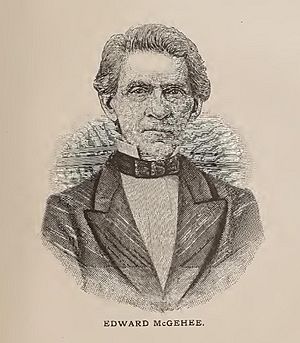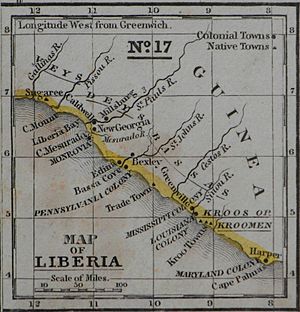Edward McGehee facts for kids
Edward McGehee (born November 8, 1786 – died October 1, 1880) was an American judge. He was also a very large-scale farmer, known as a planter, in Wilkinson County, Mississippi. He owned a huge amount of land for growing cotton. To work this land, he held nearly 1,000 enslaved people at his Bowling Green Plantation.
In the 1830s, McGehee joined other important planters to start the Mississippi Colonization Society. This group aimed to send free Black people from Mississippi to West Africa. They believed that having free Black people in a society based on slavery could cause problems. They bought land in Africa, which became known as Mississippi-in-Africa. This area later became part of the country Liberia.
Contents
Biography
Early Life and Career
Edward McGehee was born on November 8, 1786. His parents were Micajah McGehee and Ann (Scott) McGehee.
After becoming a lawyer, McGehee was made a state judge in Mississippi. He became very rich from growing cotton. His farm, called Bowling Green Plantation, was near Woodville, Mississippi. This plantation covered thousands of acres. McGehee owned almost 1,000 enslaved people to work on this large farm.
McGehee also owned a factory on his plantation that made cloth. About 100 enslaved people worked there. In 1831, he bought a railroad company in Louisiana called the West Feliciana Rail Road Company.
In the 1830s, McGehee helped create the Mississippi Colonization Society. He worked with other planters like Isaac Ross and Stephen Duncan. They also worked with a minister named Jeremiah Chamberlain. The goal of this group was to send freed Black people and free people of color to Liberia in West Africa. This group was similar to the American Colonization Society. However, it focused on people from Mississippi. In Mississippi, there were three times more enslaved people than white people.
During the American Civil War (1861–1865), McGehee supported the Union. But he also sold clothes from his factory to the Confederate States Army. In 1864, soldiers from the United States Colored Troops burned down his mansion at Bowling Green Plantation. His wife wrote about this event in a newspaper that supported the Confederacy.
Family Life
Edward McGehee married Mary Hines Burruss. They had five children, three sons and two daughters:
- Charles Goodrich McGehee (1823–1903)
- Francis William McGehee (1831–1843)
- John Burruss McGehee (1836–1913)
- Harriett Lucinda McGehee (1844–1851)
- Augusta Eugenia McGehee (1854–1882)
Death
Edward McGehee died on October 1, 1880. He passed away at his plantation in Woodville, Mississippi.
Legacy
- The famous writer Stark Young (1881–1963) was McGehee's nephew. Young wrote about the fire that destroyed the plantation house in his 1934 book So Red the Rose. He also mentioned it in his 1951 book The Pavilion.
- A church in New Orleans was once named the Edward McGehee Church of the Methodist Episcopal Church. It was built between 1851 and 1853. Later, in 1906, a group called the Freemasons bought it. They renamed it the Scottish Rite Cathedral.
- A school for girls in Mississippi was also named in his honor. It was called the Edward McGehee College of Girls. The writer Henry Walter Featherstun was its President.



